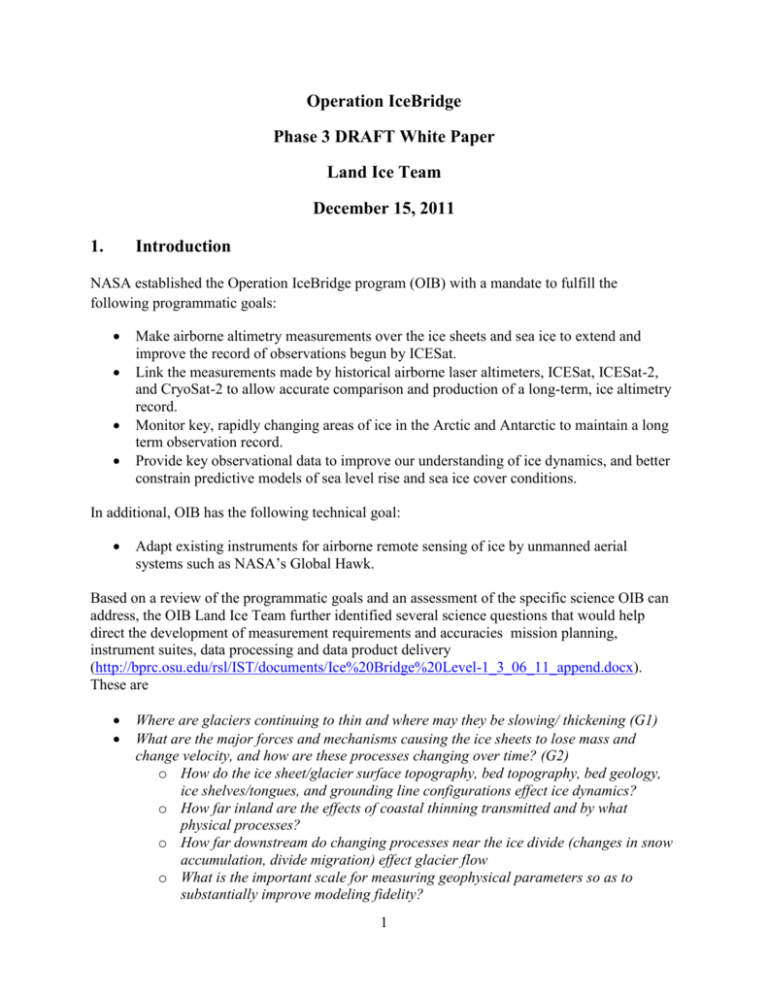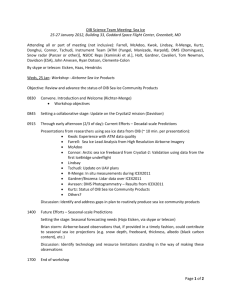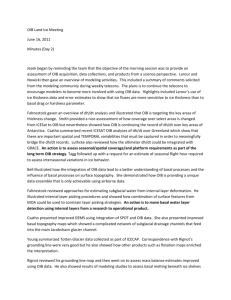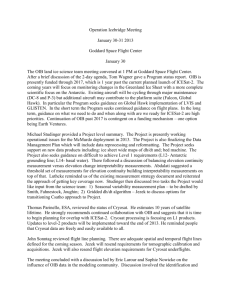Operation IceBridge_dec15 - Byrd Polar and Climate Research
advertisement

Operation IceBridge Phase 3 DRAFT White Paper Land Ice Team December 15, 2011 1. Introduction NASA established the Operation IceBridge program (OIB) with a mandate to fulfill the following programmatic goals: Make airborne altimetry measurements over the ice sheets and sea ice to extend and improve the record of observations begun by ICESat. Link the measurements made by historical airborne laser altimeters, ICESat, ICESat-2, and CryoSat-2 to allow accurate comparison and production of a long-term, ice altimetry record. Monitor key, rapidly changing areas of ice in the Arctic and Antarctic to maintain a long term observation record. Provide key observational data to improve our understanding of ice dynamics, and better constrain predictive models of sea level rise and sea ice cover conditions. In additional, OIB has the following technical goal: Adapt existing instruments for airborne remote sensing of ice by unmanned aerial systems such as NASA’s Global Hawk. Based on a review of the programmatic goals and an assessment of the specific science OIB can address, the OIB Land Ice Team further identified several science questions that would help direct the development of measurement requirements and accuracies mission planning, instrument suites, data processing and data product delivery (http://bprc.osu.edu/rsl/IST/documents/Ice%20Bridge%20Level-1_3_06_11_append.docx). These are Where are glaciers continuing to thin and where may they be slowing/ thickening (G1) What are the major forces and mechanisms causing the ice sheets to lose mass and change velocity, and how are these processes changing over time? (G2) o How do the ice sheet/glacier surface topography, bed topography, bed geology, ice shelves/tongues, and grounding line configurations effect ice dynamics? o How far inland are the effects of coastal thinning transmitted and by what physical processes? o How far downstream do changing processes near the ice divide (changes in snow accumulation, divide migration) effect glacier flow o What is the important scale for measuring geophysical parameters so as to substantially improve modeling fidelity? 1 o Where is the subglacial water produced and where is it going? How do ocean, sea ice, ice sheet interactions influence ice sheet behavior (G2) o How does the bathymetry beneath Arctic fjords and Antarctic ice shelves influence ocean/ice sheet interactions and ice sheet/glacier flow dynamics? What are yearly snow accumulation/melt rates over the ice sheets? (G1) o How do changing accumulation rates (and hence near surface densities and firn structure) impact altimetry measurements o What are the surface-melt flow-patterns and how do they change with time? OIB has now been operating successfully for over 3 years. In that time, the program has demonstrated substantial abilities to conduct science missions across Greenland, Antarctica, Arctic ice caps and Alaskan Glaciers. The resulting data sets are enriched with a variety of measurements ranging from photon counting lidar elevations to UHF radar sounding data to airborne gravity anomalies. A robust suite of geophysical parameters is routinely derived from the basic data sets (Figure 1). Data and derived products are delivered to the science community in an open and very timely fashion. Indeed a hallmark of the activity is the quick availability of the data to any interested investigator. This white paper briefly reviews the development of OIB. The white paper goes on to establish a longer term vision for OIB that leads to a hand-off of altimetric measurements to ICESat-2. Figure 1. The richness of the OIB data set is illustrated in this figure of Pine Island Glacier showing OIB surface altimetry overlain on Radarsat-1 SAR imagery. The middle layer ice bottom topography derived from depth sounding radar measurements. The lower level is the sea floor topography constructed from gravity measurements. The estimated grounding line of the glacier is shown on the basal and surface topographies (courtesy K. Jezek) 2 2. OIB Phase 1 NASA recognized there would be a gap between ICESat and ICESat-2 that could be partially filled with airborne data. During phase 1, which started in mid-2008, NASA identified available aircraft and integrated equipment wherein some of the later were still in late development stages. Based on the science need, the logistics capability, and the instrument suite, the report titled 'An analysis and summary of options for collecting ICESat-like data from aircraft (http://bprc.osu.edu/rsl/IST/documents/IceSAT_Gapfiller_final.pdf) was distributed in early 2009. The report envisioned a diverse instrument suite, identified general areas for data collection, recognized the need for a data management plan, and anticipated a gradual expansion of the aircraft fleet to include unmanned vehicles. Phase 1 very successfully seeded the OIB activity by demonstrating that successful, spatially extensive data collections could be carried out in both the Arctic and Antarctic (figure 2 and 3). Figure 2. Pre OIB coverage (1993-2008 Left) and combined coverage (1993-2011 Right) illustrating that OIB is achieving more than the previous 15 years (courtesy E. Rignot) 3 Figure 3. Antarctic coverage 2009 (courtesy M. Studinger) 3. OIB Phase 2 Broader and more formal program management was initiated during Phase 2 (the summer of 2010). NASA conducted a proposal review for various instruments and later in the fall of 2010, established the OIB science team. Based on the technologies demonstrated in Phase 1, the science team contributed two, important new facets to OIB. First, the science team developed a set of science requirements that were grounded in primary science questions and substantiated by estimates of the measurement capabilities as demonstrated in Phase 1. Relying on the science requirements, the science team proceeded to develop acquisition campaigns that could be directly traced to the science requirements. After several cycles of planning, the science team work has contributed to a more complete science definition for OIB and that our organized effort provides a smoother and more efficient interface between science and implementation. In fact the team has tried to adopt and refine a specific acquisition strategy as discussed in the next section. 2.1 Phase 2 Acquisition Strategy The OIB acquisition strategy aims to build layers of observations that optimize single observations of static variables (such as basal topography) and construct repeat coverages that efficiently lead into extending surface dh/dt time series shortly after launch of ICESat-2. The strategy has three main elements: 4 Use depth sounding radar, low elevation lidar, gravity, accumulation radar, and DMS to establish baseline data sets. o Collect data along closely spaced flight lines (5 km or less) roughly parallel to elevation contours near the coast and which extend seaward of the ice margin. o Collect data along more widely separated flight lines (10-20 km) roughly parallel to elevation contours inland of about the 400 m/yr surface velocity contour (speed number is just a placeholder right now). o Collect data on flight lines along center lines of most Greenland and Antarctic glaciers and which selectively extend across the ice divide. In general it is preferable to collect coincident radar and altimeter data early in the project. Using high elevation lidar and DMS for extending coverage and for repeat elevation measurements o Fill regions between low elevation flight lines o Repeat acquisitions in succeeding years for dh/dt Use both the extended and base data sets to construct a spatial and temporal coverage sufficient for improving ICEsat cross track slope errors, tying ICEsat and OIB data to the Cryosat data set, connecting all earlier data sets to the ICEsat-2 data set. The coverage should be sufficient to allow an assessment of regional ice sheet elevation change shortly after the start of the ICEsat-2 mission. High elevation coverage strategies are illustrated in figure 5 which shows B-200 LVIS coverage over Greenland. The notion behind the coverage is to fill in boxes around the ice sheet that form a baseline elevation data set for bridging ICESat and ICESat-2 observations. Selected ICESat repeat tracks are also included in the ensemble of observations. 5 Figure 5. B200 LVIS coverage in 2011 (courtesy J. B. Blair and M. Hofton) 6 2.2 Science Contributions 2.2.1 Long term records Airborne platforms can be used to make measurements at specific points that might be inaccessible by satellites operating in a fixed orbital geometry. This capability is especially important for extending the records of earlier in situ observations. Figure 6 shows a 29 year record of surface elevation change (10 cm/yr increasing rate of surface elevation) for sites in South Central Greenland and originally established by The Ohio State University. The combination of Doppler satellite elevations, in situ GPS observations, ATM overflights and slope corrected ICESat data provide a convincing measure of the trend. Moreover, when combined with other geophysical data can be used to demonstrate that thickening in this western sector of the ice sheet is driven by increasing accumulation which falls on a land terminating flow band (western and central cluster). Thinning east of the divide (Dye-3) is probably driven by changes in stresses at the ocean terminating terminus. Figure 6. 29 year record of elevation change in south central Greenland. In situ Doppler satellite and GPS measurements (red), ATM measurements (blue) and slope corrected ICESat measurements green at OSU Clusters. Central Cluster site 2001 located at 46.7 W, 65.1 N. (courtesy K.Jezek) 4. OIB Phase 3 Key logistical, instrumental, and science elements of a sustainable Phase 2 activity are now in place. Moreover, additional instruments and valuable aircraft assets have been added to the OIB portfolio subsequent to Phase 1. An ambitious set of science requirements is in place that is intrinsically extensible to larger geographic regions with more temporal sampling. With those developments and with planning experience in hand, the program can turn its attention to several emerging issues. These are summarized in the following sections. 7 4.1 Phase 3 Measurement Strategy OIB is meant to provide data to improve our understanding of the mass evolution of the ice sheets and major mountain glaciers, their vulnerability to climate change and their contribution to sea-level. In particular, the data will help characterize and understand the processes governing change. OIB will uniquely improve our understanding in specific targeted local areas at spatial resolutions that satellite data cannot capture, and to improve the larger spatial scale (but smaller temporal scale) observations acquired by satellite data (e.g. I-1, I-2 and GRACE and GRACE-2). Of course, OIB is also collecting data during a gap in satellite laser altimetry. Therefore OIB during Phase 3 should: Carefully vet data sets to be sure that the desired geophysical products (for example bottom topography) are derivable from the ensemble of observations continue to targets "hot spots" identified by satellite and other data to provide very detailed spatial sampling for characterization and modeling, and to improve satellite measurement model algorithms and performance assessment. This would be focused area mapping or dense grid and flowline mapping of "hot spots", and Icesat line coverage. provides large scale spatial sampling to provide a fundamental datum to link past and future satellite missions. This would be large area gridding, which provides sufficient sampling for current and future predicted change and to acquire enough collocated satellite/airborne data. utilize recently developed tools to automatically create optimized flight lines. 4.2 Increasing spatial and temporal sampling Aircraft resources envisioned in Phase 1 limit spatial and temporal coverage. These issues have now been partly mitigated by the good cooperation with other groups including University of Texas and University of Alaska which provide complementary data sets. However vast areas of the Antarctic remain inaccessible and temporal sampling of the Arctic is woefully inadequate. Consequently, there are unresolved issues regarding logistics that must be resolved before we can extend the reach of OIB. Spatially, this means configuring aircraft for operations to map the Antarctic grounding line. Achieving this goal requires suitable aircraft along with agreements between international partners to support extended missions. Temporally, this mandates several observations over the course of the year are needed to understand short term variability in outlet glacier elevation in Greenland. Achieving more frequently temporal coverage without overly stressing instrument and flight crews dictates a transition to unmanned vehicles. Continued diversification of the available aircraft should be considered to potentially include vehicles that fly lower and slower. Accurate inversion of gravity data collected over the complex terrain of Greenland may require denser sampling and more accurate measurements of 8 gravitational acceleration. A key task for the science team will be to assess the current data set and to make recommendations on necessary characteristics for future platforms. 4.3 Advanced Technologies OIB should be flexible to exploit advanced technologies such as radar tomography. This approach is now demonstrated to yield coincident cross track estimates of surface and basal topography and radar reflectivity. These are deemed critical for detailed studies of select glaciers (figure). Here instruments and mission profiles have to be optimized for the more site specific applications of this revolutionary technique. Figure 7. Tomographically derived surface and basal topography (left) for Russel Glacier (right). Ice thickness is about 1000 m. (Courtesy of X. Wu and J. Paden). Similarly, OIB should be quick to integrate technologies. For example, sub-ice-shelf bathymetry from gravity (Figure 8) can be merged with radar ice thickness on grounded ice to provide a seamless view of the subglacial terrain. Gravity and radar may also provide important complementary information where the physical situation proves challenging for one or the other of the measurement techniques. 9 Figure 8. Gravity derived, sub-glacial bathymetry for Pine Island Glacier. Image courtesy of J. Cochran, E. Rignot, and M. Studinger (Fogt, 2011). 4.2 An end-to-end view of OIB To answer the science questions posed at the outset, OIB must evolve to an end to end system wherein data planning, data collection, and analysis flow smoothly into models with a quick (6 month) turn around. This evolution is important for two reasons. Establishing the flow ensures that the science team is making good choices for future aircraft deployments along with assuring that the collected data are vetted for scientific utility. As importantly, this mission-oriented flow will mean that OIB focuses attention on answering key science questions. This last point is fundamentally important. Said differently, OIB will be most successful when viewed as a mission with all of its resources working in a coordinated way to solve key questions. While individual, exploratory research will remain an element of OIB, the more encompassing approach to OIB research will become the dominant theme. 10 5. OIB Phase 4 The last OIB phase has several goals which primarily focus on the hand-off to ICESat-2. Prior to ICESat-2 launch and once the orbit geometry has been fixed, OIB will conduct measurement campaigns that optimize coverage beneath ICESat-2 measurement footprints. Along with establishing a data set to vet ICESat-2 elevations close to the launch time frame, the data will be crucial for validating ICESat-2 multibeam slope corrections. After launch, OIB will continue underflights to establish an overlap data set sufficient to connect the ICESat, OIB, and ICESat-2 data sets. Work will be required in the Arctic and Antarctic suggesting about a 1 year period of joint operations. Once the overlap period is over, there is a strong case to be made for maintaining a modified OIB operation based on the complementary characteristics of airborne and spaceborne data instruments. These include: 1) The navigational flexibility of airborne instruments is crucial for maintaining the most accurate time series over fixed sites and for spatially interpolating satellite data. Aircraft provide an invaluable tool for refining trends and understanding processes. Even in cases where the early observations may have large errors, differences in a geophysical parameter increased with time may well outweigh the instrumental uncertainties. Future remeasurements of Antarctic traverse lines from the 1950’s and 60’s may soon prove fruitful. 2) Combinations of in situ, airborne and satellite data greatly increase the interpretability of the data sets and increase the confidence in the interpretation of those data. Multiple, independent estimates of a parameter (for example free air gravity and altimetry) also increase confidence. 3) A rich suite of measurements is required to capture the complete ensemble of glaciological parameters necessary to interpret the behavior of the ice sheet. Presently, there are several essential measurements that can only be made from aircraft including subglacial topography and ocean bathymetry as well as near surface accumulation rates. 4) Airborne measurements provide a unique flexibility to acquire data over short term or unexpected phenomena. Figure 9 illustrates a recently acquired and initially unplanned set of measurements across a crack developing in the Pine Island Glacier. Data of this sort are invaluable in understanding crack formation and assessing the likelyhood that the phenomena is a routine, episodic calving event or a harbinger of more drastic ice shelf retreat. 11 Figure 9. Satellite and OIB data showing a developing rift on Pine Island Glacier, October, 2011. Upper image is a TerraSAR-X image (courtesy Dana Floricioiu, DLR). The middle scene shows DMS details of the rift. The lower scene shows ATM surface elevations along the rift. Depth sounding radar data were also acquired along and across the rift. (composite courtesy of M. Studinger). 6. References Fogt, R. L., Ed., 2011: Antarctica in State of the Climate in 2010, Bull. Amer. Meteor. Soc., 92 (6), S161-171. Koenig, L., S. Martin, M. Studinger, and J. Sonntag (2010), Polar airborne observations fill gap in satellite data, Eos Trans. AGU, 91(38), 333–334. 12 13








